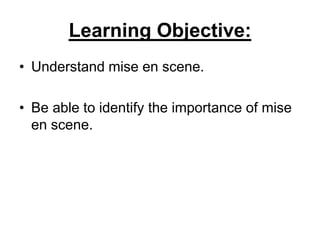Mise en scene
- 1. Learning Objective: âĒ Understand mise en scene. âĒ Be able to identify the importance of mise en scene.
- 2. Mise en Scene âĒ Mise-en-scene is a French term meaning âwhat is put into the scene or frame.â âĒ mise, putting + en, on + scÃĻne, stage It is pronounced: âĒ meez ahn sen
- 3. Mise en Scene âĒ What is put in or left out can make a big difference to the signals we, the audience, receive about what sort of film it is and how we are supposed to feel at this point.
- 4. Mise en Scene For example, a simple shot of a tree can be made to look threatening by stripping it of leaves, adding a vulture and some lightening and shooting it in darkness. The same tree can be made to look happy and non- threatening by having children playing beneath it its sunlit branches.
- 5. 1. Setting and Props âĒ The settings used in a film are very rarely just backgrounds to the characters dialogue and indeed we will often see shots of places, without any action taking place. They can be used to influence an audience by building certain expectations and then the action takes a different turn, e.g. in a horror set in a normal city setting.
- 6. 1. Setting and Props âĒ A prop is the term we give to objects in the setting which play a part in the action, rather than just being part of the background, for example, a glass containing some poisoned wine.
- 7. 2. Costume, Hair and Make-up Costume Costume plays a large part in the mise-en-scene because it can be an instant to us all of a characterâs personality, social status and job. It tells us immediately whether the film is set in the present and what society and/or culture it will centre around. It may also provide a clue as to the part the character will play in the action. Certain types of costume are identified closely with individual genres. Can you think of any?
- 8. 2. Costume, Hair and Make-up Make-up In the early days of cinema, make-up was used to highlight facial features as black and white film stock could not register detail very well. Certain genres traditionally use make-up more than others. Consider; What costume features would you expect to see in a western? What costume features do you associate with villans?/ Heroes? Which genres do you think make more use of make-up and why?
- 9. 3. Facial Expressions and Body Language Facial Expressions Facial expressions are a clear indicator of how someone is feeling. Small changes to someoneâs face can send out totally different signals; if someone is smiling broadly we assume they are happy, but if this is held for too long we begin to worry as this is not normal behaviour. Eyes give particularly important signals to us when we are trying to read someoneâs expression and it is usual for us to follow the direction of their sight, so if a filmmaker wants to draw attention to a feature s/he can use this to make the audience focus on something or someone in the frame
- 10. 3. Facial Expressions and Body Language Body Language The way in which we hold and move our bodies also indicates how we are thinking and feeling. As with facial expressions, everyone is different, but there are some things which we all recognise such as curling up into a ball to protect ourselves or shaking a fist at someone to express anger.
- 11. 4. Lighting and Colour âĒ These elements help to create mood and atmosphere. âĒ The audienceâs attention can be guided by lighting an object âĒ A director can use shadows to build up suspense by concealing items in the scene from the audience. âĒ Alternating bright and dark light can be used to create an effect of confusion. âĒ The connotations carried by colours can be used to support mood â red, black and greens etc. âĒ The absence of vivid colours where these might be expected or changes in use of colour by the director should be noted. âĒ These are elements often analysed as part of mise-en-scene.
- 12. 5. Positioning of characters & objects within a frame. There are various ways in which the filmmaker can use positioning within the frame. For instance; âĒ If the filmmaker chooses to position a character or an object in the foreground of the shot we know that we, as an audience, should attach importance to this character or object. âĒ A moving body or object placed against a stationary background will immediately draw our attention as it would in real life. âĒ If characters or objects are positioned evenly within the frame this will give a balanced feel to the shot. All figures at one end of the shot would make it appear imbalanced. âĒ The filmmaker can use positioning to indicate relationships between people, for example, if lovers are having an argument they will often be placed at the outside edges of the frame so that there is a lot of physical distance between them. This reflects the emotional distance they are experiencing at this point.
- 13. Mise en Scene - Examples As we look at film stills, try to identify: âĒ which aspects of mise en scene have been used âĒ Donât just consider denotation - connotation is important!
- 14. Lighting Position of objects within frame Very dark so the lit window and the figure stand out. Off- centre. Door slightly obscured.
- 15. Lighting Position of objects within frame
- 16. Lighting Facial expression Props
- 17. Facial expression Position within frame
















